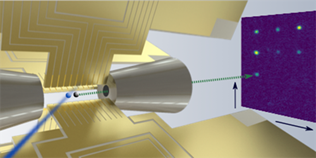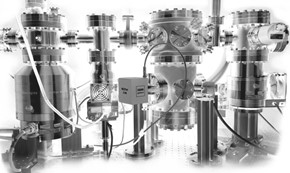Light Matter Interaction
Nanoscale single atom heat engine
While thermodynamic systems are generally treated by averaging over many body systems, we seek to scale such systems down to the ultimate limit of a single atom [1,2]. We have experimentally demonstrated a nanoscale heat engine using a single ion as working gas. A Sterling-cycle engine were implemented by confining the ion in a linear Paul trap with tapered geometry and coupling it to engineered reservoirs. The publication was elected by Physics world under the top ten physics break-throughs of the year 2016. To realize such a heat engine, a single ion is trapped in a linear Paul trap with tapered geometry (see Fig. 1). It couples to thermal reservoirs which are engineered by laser radiation and tailored electronic noise on the electrodes. These reservoirs heat and cool the radial thermal states of the ion alternately. The cycle of heating and cooling is repeated resonantly with the axial Eigen frequency of the ion, transducing a change in temperature in the radial state into a coherent movement along the trap's symmetry axis. This experiment opened a new realm for investigating thermodynamics at the single-atom level and in the quantum regime. Throughout this project we seek to provide experimental answers to many interesting questions when thermodynamics meet the quantum world. This project is currently funded by the Forschergruppe “Thermal machines in the quantum regime”.

Quantum Money and Nanosensors
This project is funded by the Volkswagen Foundation was started in Kassel by the working groups around Singer, Koch, Reithmaier and Popov. The goal of this project is to use the no-cloning theorem of quantum mechanics to produce non-duplicable quantum tokens and to use this technique to develop improved quantum sensors. Because the necessary optimization of the systems against decoherence effects enables the implementation of more selective sensors. By using Optimal Control methods developed in the AG Koch optimized pulse sequences can be developed to achieve these goals.
Atomic nano-implanter
The atomic nano-implanter allows precise and deterministic inclusion of single atoms in solid-state systems (see Fig. 2). Single dopant atoms or dopant-related defect centers in a solid state matrix are of particular importance among the physical systems proposed for quantum com-puting and communication, due to their potential to realize a scalable architecture compatible with electronic and photonic integrated circuits.

Here, using a deterministic source of single laser-cooled praseodymium ions, we present the fabrication of arrays of praseodymium color centers in yttrium-aluminum-garnet substrates. The beam of single praseodymium ions is extracted from a Paul trap and focused down to 30(9) nm. Using a confocal microscope, we determine a conversion yield into active color centers of up to 50% and realize a placement precision of 34 nm. [3]. This project is currently funded by the Volkswagen Foundation and the LOEWE initiative SMolBits.
Quantum sensing of chiral molecules with Rydberg atoms
Funded by the SFB ELCH the group is currently setting up a new experiment for the use of Rydberg atoms as sensitive quantum sensors for chiral molecules. We will be using quantum sensing techniques to sense chirality of molecules from a molecular beam setup (see Fig. 3).

Refrences
[1] A single-atom heat engine, Science, 352, 325-329 (2016).
[2] Transient non-confining potentials for speeding up a single ion heat pump, New Journal of Physics, 20, 105001 (2018).
[3] Karin Groot-Berning, Thomas Kornher, Georg Jacob, Felix Stopp, Samuel T. Dawkins, Roman Kolesov, Jörg Wrachtrup, Kilian Singer, and Ferdinand Schmidt-Kaler. Phys. Rev. Lett. 123, 106802 (2019).
Prof. Dr. Kilian Singer
full member
- Location
- Universität Kassel
Fachbereich 10 - Naturwissenschaften & Mathematik
Institut für Physik
Heinrich-Plett-Straße 40
34132 Kassel
- Room
- 1166
- Telephone
- +49 561 804-4235
- ks[at]uni-kassel[dot]de
- Website
- Licht-Materie-Wechselwirkung
